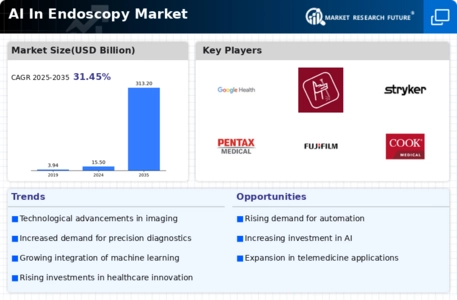Growing Focus on Patient-Centric Care
The shift towards patient-centric care is a significant driver for the AI In Endoscopy Market. Healthcare systems are increasingly prioritizing patient experiences and outcomes, leading to a demand for technologies that enhance the quality of care. AI in endoscopy offers solutions that not only improve diagnostic accuracy but also streamline procedures, reducing recovery times and enhancing patient comfort. This focus on patient-centric approaches is reflected in the growing adoption of minimally invasive techniques, which are often facilitated by AI technologies. As healthcare providers strive to meet the expectations of informed patients, the AI In Endoscopy Market is likely to see continued growth, as it aligns with the broader trend of personalized medicine.
Technological Advancements in Imaging
Technological advancements in imaging techniques are significantly influencing the AI In Endoscopy Market. Innovations such as high-definition imaging, 3D visualization, and real-time data analysis are enhancing the capabilities of endoscopic procedures. These advancements allow for more precise identification of lesions and abnormalities, thereby improving diagnostic accuracy. The integration of AI algorithms with these advanced imaging technologies enables automated detection and classification of findings, which can reduce the workload on healthcare professionals. As a result, the market is witnessing an influx of AI-powered endoscopic devices that leverage these technologies. The potential for improved patient outcomes and operational efficiency is likely to drive further investment in the AI In Endoscopy Market.
Rising Demand for Early Disease Detection
The AI In Endoscopy Market is experiencing a notable surge in demand for early disease detection, particularly in gastrointestinal disorders. As healthcare providers increasingly recognize the importance of timely diagnosis, the integration of artificial intelligence into endoscopic procedures is becoming more prevalent. AI technologies enhance the ability to identify abnormalities at earlier stages, which can lead to improved patient outcomes. According to recent estimates, the market for AI in endoscopy is projected to grow at a compound annual growth rate of over 20% in the coming years. This growth is driven by the increasing prevalence of conditions such as colorectal cancer, where early detection is crucial. Consequently, the AI In Endoscopy Market is positioned to play a pivotal role in transforming diagnostic practices.
Regulatory Support and Reimbursement Policies
Regulatory support and favorable reimbursement policies are crucial factors propelling the AI In Endoscopy Market. Governments and health authorities are increasingly recognizing the potential of AI technologies to improve healthcare delivery. As a result, there is a growing trend towards establishing regulatory frameworks that facilitate the approval and integration of AI solutions in clinical practice. Additionally, reimbursement policies that cover AI-assisted endoscopic procedures are becoming more common, which encourages healthcare providers to adopt these technologies. This supportive environment is likely to enhance the market's growth trajectory, as it reduces financial barriers for both providers and patients. The AI In Endoscopy Market stands to benefit from these developments, fostering innovation and accessibility.
Increasing Investment in Healthcare Technology
The increasing investment in healthcare technology is a driving force behind the AI In Endoscopy Market. As healthcare organizations seek to enhance operational efficiency and improve patient outcomes, there is a growing allocation of resources towards advanced technologies, including AI. Venture capital and private equity investments in health tech have surged, with a significant portion directed towards AI applications in diagnostics and treatment. This influx of capital is fostering innovation and accelerating the development of AI-powered endoscopic solutions. Furthermore, partnerships between technology companies and healthcare providers are becoming more prevalent, creating a collaborative ecosystem that supports the advancement of AI in endoscopy. This trend is likely to sustain the momentum of the AI In Endoscopy Market in the foreseeable future.


















Leave a Comment